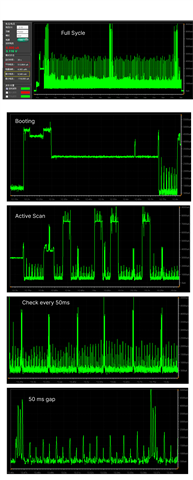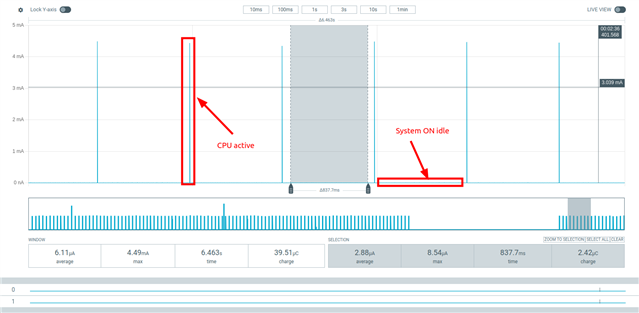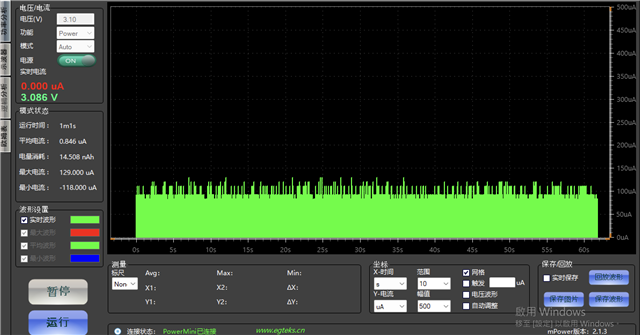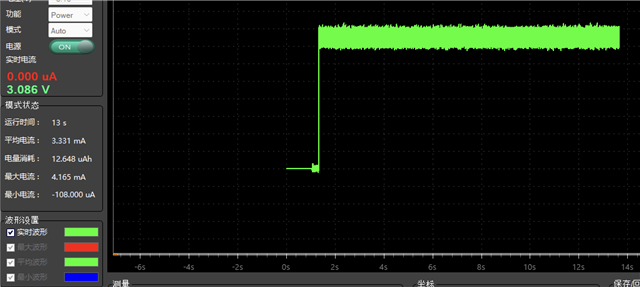Hello~
I am developing nrf52840 with zephyr ncs tool chain v2.7.0 and SDK v2.6.1.
Our hadware is very simple, just a power IC, a nrf52840 and a G-sensor.
Our pre-production PCB average current is 600uA when normal operating. We want to minimize it to around 120uA (This is the estimate current value we get from here: Online Power Profiler for Bluetooth LE )
When normal operation, without scan, with advertising and sleep 100 ms in main loop. And we turned on ADC, I2C also.
And when normal operation, G-sensor is off.
We turn on DCDC also.
This is our Device tree, we had turned off all unused function blocks.
/ {
zephyr,user {
io-channels = <&adc 0>;
};
// redefine button pins
// Left : buttonL
// Right : buttonR
// Up: buttonU
// Down : buttonD
// PWR : buttonP
buttons {
compatible = "gpio-keys";
debounce-interval-ms = <200>;
buttonL: button_0 {
gpios = <&gpio0 26 (GPIO_PULL_UP | GPIO_ACTIVE_LOW)>;
label = "Left button switch 1";
zephyr,code = <INPUT_KEY_0>;
};
buttonR: button_1 {
gpios = <&gpio0 27 (GPIO_PULL_UP | GPIO_ACTIVE_LOW)>;
label = "Right button switch 2";
zephyr,code = <INPUT_KEY_1>;
};
buttonU: button_2 {
gpios = <&gpio0 6 (GPIO_PULL_UP | GPIO_ACTIVE_LOW)>;
label = "Up button switch 3";
zephyr,code = <INPUT_KEY_2>;
};
buttonP: button_3 { // the middle one
gpios = <&gpio0 7 (GPIO_PULL_UP | GPIO_ACTIVE_LOW)>;
label = "Down button switch 4";
zephyr,code = <INPUT_KEY_3>;
};
buttonB: button_4 { // the bottom one
gpios = <&gpio0 5 (GPIO_PULL_UP | GPIO_ACTIVE_LOW)>;
label = "Power button switch 5";
zephyr,code = <INPUT_KEY_5>;
};
};
leds {
compatible = "gpio-leds";
led0: led_0 {
gpios = <&gpio1 4 GPIO_ACTIVE_LOW>;
label = "Red LED 0";
};
led1: led_1 {
gpios = <&gpio1 7 GPIO_ACTIVE_LOW>;
label = "Green LED 1";
};
led2: led_2 {
gpios = <&gpio1 6 GPIO_ACTIVE_LOW>;
label = "Blue LED 2";
};
};
aliases {
btn0 = &buttonL;
btn1 = &buttonR;
btn2 = &buttonU;
btn3 = &buttonP;
btn4 = &buttonB;
};
gpio-inputs
{
compatible = "gpio-keys";
gsensor_int: gsensor_int {
gpios = <&gpio0 11 (GPIO_ACTIVE_HIGH)>;
label = "g-sensor interrupt";
zephyr,code = <INPUT_KEY_6>;
};
};
gpio-outputs
{
compatible = "gpio-leds";
adc_en: adc_en {
gpios = <&gpio0 3 GPIO_ACTIVE_HIGH>;
label = "ADC enable";
};
};
};
&adc {
#address-cells = <1>;
#size-cells = <0>;
status= "okay";
channel@0 {
reg= <0>;
zephyr,gain = "ADC_GAIN_1_6";
zephyr,reference = "ADC_REF_INTERNAL";
zephyr,acquisition-time = <ADC_ACQ_TIME(ADC_ACQ_TIME_MICROSECONDS, 10)>; //<ADC_ACQ_TIME_DEFAULT> : 10us
zephyr,input-positive = <NRF_SAADC_AIN2>; // P0.04
zephyr,resolution = <12>;
zephyr,oversampling = <8>;
};
};
&i2c0 {
compatible = "nordic,nrf-twim";
status = "okay";
clock-frequency = <100000>;
pinctrl-0 = <&i2c0_default>;
pinctrl-1 = <&i2c0_sleep>;
zephyr,concat-buf-size = <64>;
zephyr,flash-buf-max-size = <64>;
/*Gsensor:Gsensor@50 {
compatible = "i2c-device";
label = "i2c Gsensor addr 0x50";
reg = <0x50>;
};*/
};
&pinctrl {
i2c0_default: i2c0_default {
group1 {
psels = <NRF_PSEL(TWIM_SDA, 0, 12)>,
<NRF_PSEL(TWIM_SCL, 0, 13)>;
};
};
i2c0_sleep: i2c0_sleep {
group1 {
psels = <NRF_PSEL(TWIM_SDA, 0, 12)>,
<NRF_PSEL(TWIM_SCL, 0, 13)>;
low-power-enable;
};
};
// reserve form mp debug
uart0_default: uart0_default {
group1 {
psels = <NRF_PSEL(UART_TX, 0, 29)>,
<NRF_PSEL(UART_RTS, 0, 8)>;
};
group2 {
psels = <NRF_PSEL(UART_RX, 0, 30)>,
<NRF_PSEL(UART_CTS, 0, 7)>;
bias-pull-up;
};
};
uart0_sleep: uart0_sleep {
group1 {
psels = <NRF_PSEL(UART_TX, 0, 29)>,
<NRF_PSEL(UART_RX, 0, 30)>,
<NRF_PSEL(UART_RTS, 0, 8)>,
<NRF_PSEL(UART_CTS, 0, 7)>;
low-power-enable;
};
};
};
//uart0 confict with button3,4
&uart0 {
status="disabled";
};
&uart1 {
status="disabled";
};
&pwm0 {
status="disabled";
};
&i2c1 {
status="disabled";
};
&spi0 {
status="disabled";
};
&spi1 {
status="disabled";
};
&qspi {
status="disabled";
};
&spi3 {
status="disabled";
};
&ieee802154 {
status="disabled";
};
&usbd {
status="disabled";
};
&power {
status = "okay";
};
&clock {
status = "okay";
};
&acl {
status = "disabled";
};
&cryptocell {
status = "okay";
};
&temp {
status = "disabled";
};
&nfct {
status = "disabled";
};
&wdt {
status = "disabled";
};
This is power management settings in our project:
CONFIG_PM_DEVICE=y
CONFIG_PM_DEVICE_RUNTIME=y
CONFIG_POWEROFF=y
CONFIG_PM_CPU_OPS=y
CONFIG_BOARD_ENABLE_DCDC=y
Do you have any ideas on "how to minimize operating current to 120 uA " ?






